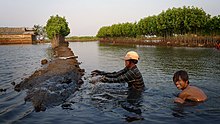Freshwater prawn farming
Unique problems are introduced by the developmental life cycle of the main species (the giant river prawn, Macrobrachium rosenbergii).
About 200 species in the genus Macrobrachium live in the tropical and subtropical climates on all continents except Europe and Antarctica.
Giant river prawns live in turbid freshwater, but their larval stages require brackish water to survive.
BC males protect the females until their shells have hardened; OCs and SMs show no such behavior.
Giant river prawns have been farmed using traditional methods in Southeast Asia for a long time.
First experiments with artificial breeding cultures of M. rosenbergii were done in the early 1960s in Malaysia, where it was discovered that the larvae needed brackish water for survival.
Industrial-scale rearing processes were perfected in the early 1970s in Hawaii, and spread first to Taiwan and Thailand, and then to other countries.
Due to the aggressive nature of M. rosenbergii and the hierarchy between males, stocking densities are much lower than in marine penaeid shrimp farms.
The prawns are cultured at much lower densities, meaning less concentrated waste products and a lesser danger of the ponds becoming breeding places for diseases.
Freshwater prawn farms do not endanger mangroves, and are better amenable to small-scale businesses run by a family.

